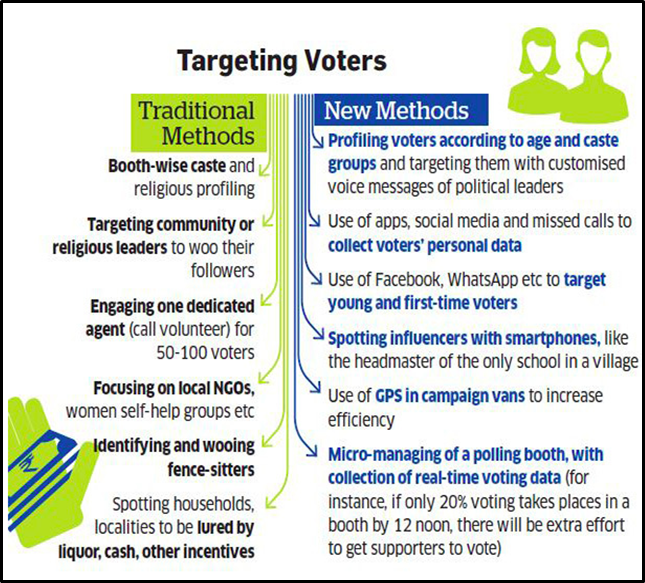THE LAST OLD-STYLE ELECTION?
Syllabus:
GS- 2:
Government policies and interventions
GS-3:
IT & Computers
Why in the news?
The potential end of traditional Indian election campaigns due to digitalization and evolving voter engagement methods.
source:theeconomictimes
Focus:
- The significant changes in Indian electoral politics suggests that the 2024 general election might be the last to follow traditional campaigning methods.
- It examines the impact of digitization on society and political communication, highlighting how modern technology and changing voter behaviour are transforming election campaigns.
About Digitalization of Society and Political Communication:
- Shift to Digital Platforms: The increasing reliance on digital platforms for political communication reflects a broader societal shift towards digitalization.
- Short Attention Spans: Modern voters, accustomed to fast-changing news cycles and constant updates, have shorter attention spans, influencing how political messages are crafted and delivered.
- Reality TV Influence: Campaigns now resemble reality TV shows, with constant updates, controversies, and ‘game-changers’ designed to capture and hold public attention.
| About the Innovations of Election Commission of india in ICT:
SVEEP Portal:
cVIGIL App:
ENCORE Scrutiny Application:
ENCORE is “Election Commission Online Nomination, Constitution, and Redressal System for Elections.” Voter Turnout App:
Voter Helpline Mobile App:
|
Understanding Traditional Campaigning vs. Modern Methods:
- Traditional Methods: Historically, Indian elections involved extensive ground campaigns, rallies, and door-to-door canvassing.
- Modern Shift: There’s a noticeable shift towards digital campaigns, leveraging social media, targeted advertising, and data analytics to reach voters.
- Efficiency and Reach: Digital campaigns are more efficient and have a broader reach, allowing parties to engage with voters directly and in real-time.
Voter Turnout and Campaign Dynamics:
- Voter Turnout Trends: The 2019 general election saw high voter turnout, partly due to emotive issues like the Pulwama-Balakot incident. The 2024 election might not see the same levels of turnout.
- Heat and Fatigue: The long and exhausting nature of traditional campaigns, combined with extreme weather conditions, may contribute to voter fatigue and lower turnout.
- Strategic Changes: To adapt, political parties might need to re-evaluate their campaign strategies, focusing more on digital engagement rather than large rallies and physical campaigning.
The Role of Media and Public Relations:
- Media Ecosystem: Campaign managers, PR agencies, and media gurus play a crucial role in shaping public perception through continuous coverage and analysis.
- Influence on Voting Preferences: Despite the media frenzy, the actual impact on voting preferences is debatable. Voters often make up their minds independently of media narratives.
Regional Variations in Voter Turnout:
- Strongholds and Minority Populations: Different regions report varying voter turnout rates, influenced by local dynamics and demographic factors.
- BJP’s Strongholds: Areas considered strongholds for the BJP may show different turnout patterns compared to regions with significant minority populations.
- Election Momentum: Each election has its own momentum and logic, influenced by regional issues and the effectiveness of campaign strategies.
The Future of Election Campaigns:
- 2024 as a Turning Point: The 2024 election might mark the end of traditional campaign methods, making way for more digitally-driven approaches in future elections.
- Preparation for 2029: By 2029, it is expected that political campaigns will be fully adapted to digital platforms, with new strategies tailored to the digital age.
AI’s Role in the Electoral Landscape:
- Campaign Strategy and Targeting: Analyses voter data for tailored messaging.
- Predictive Analytics: Forecasts outcomes using polling data, economic indicators, and social media sentiment.
- Voter Engagement: Utilises chatbots and virtual assistants for voter interaction and turnout.
- Security and Integrity: Detects election fraud and disinformation.
- Regulation and Oversight: Monitors political advertising and campaign finance compliance.
- Case Study: Bihar Election Commission used AI for transparency in 2021 panchayat elections.
Concerns of Deploying AI for Electoral Purposes:
- Manipulation of Electoral Behavior: AI can spread disinformation, create deep fakes, and highly personalised propaganda, leading to voter confusion and manipulation.
- Deep Fake Videos: AI can generate fake videos to tarnish opponents’ images, threatening election integrity.
- “Deep Fake Elections”: Convincing fake content can deceive voters, undermining public trust.
- Cambridge Analytica Example: Demonstrates the dangers of AI-driven voter manipulation.
- Messaging and Propaganda: AI enables microtargeting and campaign customization in regional languages.
- Spreading Disinformation: AI can massively scale misinformation, surpassing past scandals like Cambridge Analytica.
- Inaccuracies and Unreliability: AI models can produce inaccuracies, posing societal threats.
- Ethical Concerns: Issues of privacy, transparency, fairness, and potential bias in AI algorithms.
- Resource Disparity: AI usage advantages well-resourced parties, disrupting electoral fairness.
Challenges:
- Rapid Technological Advancements: Difficult to regulate due to the fast pace of AI development and global online platforms.
- Expertise Gap: Governments and election authorities may lack expertise to regulate AI-driven electoral activities.
- Existing Laws: Indian Penal Code, IT Act, and IT Rules address fake news but not AI and deep fake specifics.
Way Forward/Dealing With the Impacts of AI on Elections:
- MCC-like Guidelines: Issue regulations for AI transparency and political advertisement funding disclosure.
- Education and Media Literacy: Teach citizens to evaluate information and identify disinformation.
- Enhanced Fact-Checking: Establish Rapid Response Teams and support fact-checking organisations.
- Counter-Narratives: Launch campaigns to debunk misinformation and provide accurate counter-messages.
- Ethical AI Development: Promote ethical AI with standards for bias, privacy, and transparency.
Conclusion:
The transformation in political campaigning driven by digitalization and changing voter behaviour.It suggests that the traditional methods of electioneering might be on their way out, replaced by more efficient and far-reaching digital campaigns.As society continues to digitalize, political communication will evolve accordingly, leading to significant changes in how elections are conducted and how voters are engaged.
Source: The Economic Times
Mains Practice Question:
“Discuss the impact of digitalization on Indian electoral politics, with a focus on how it has transformed traditional campaigning methods and voter engagement. Analyse whether the 2024 general election could mark the end of old-style election campaigns in India. Provide examples to support your arguments.”




